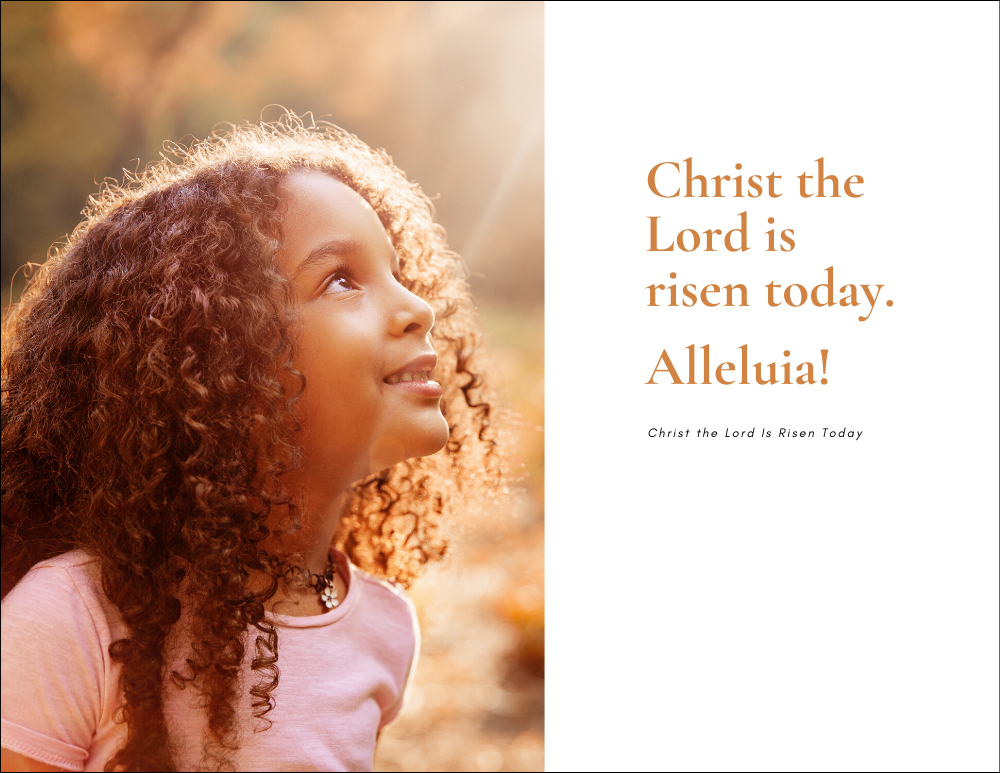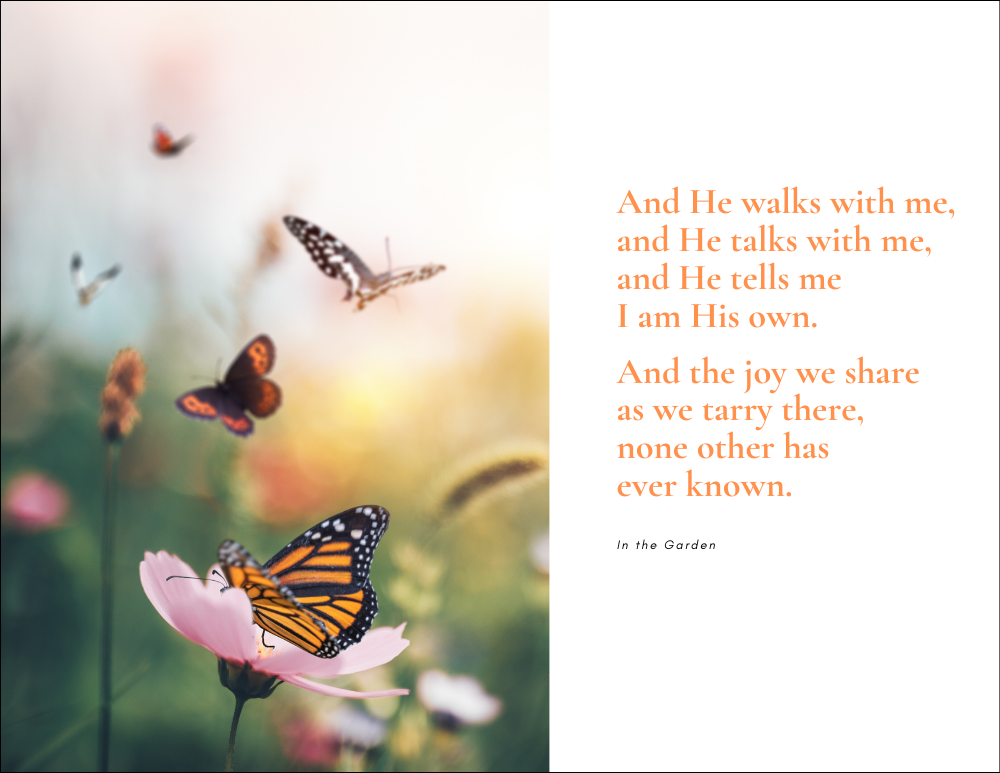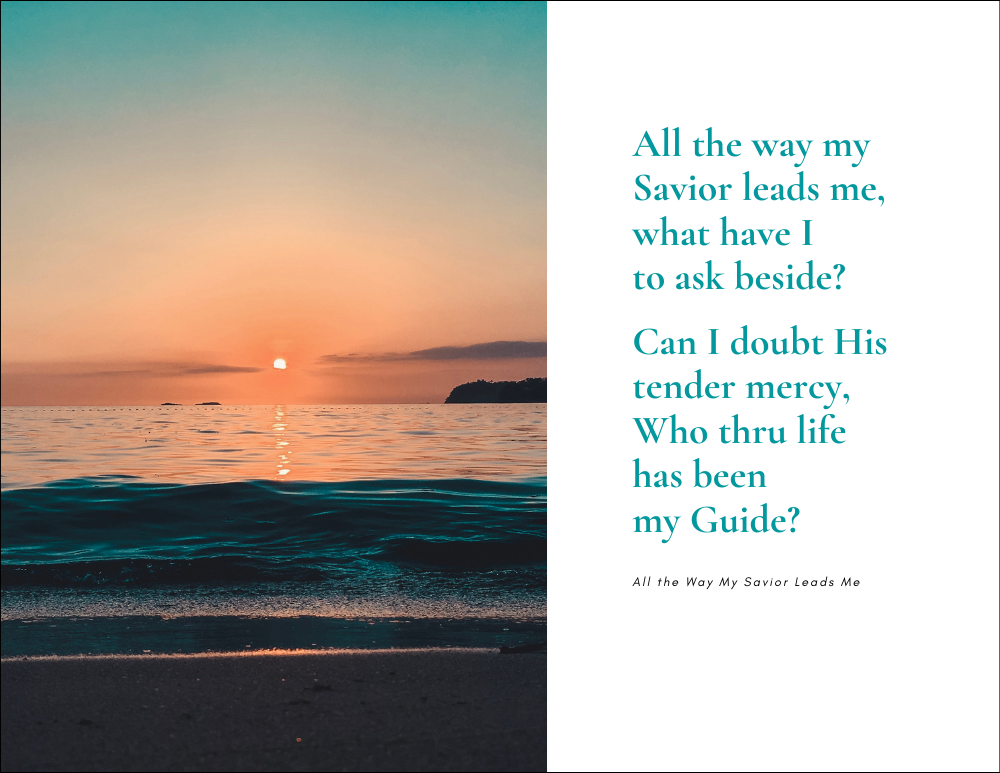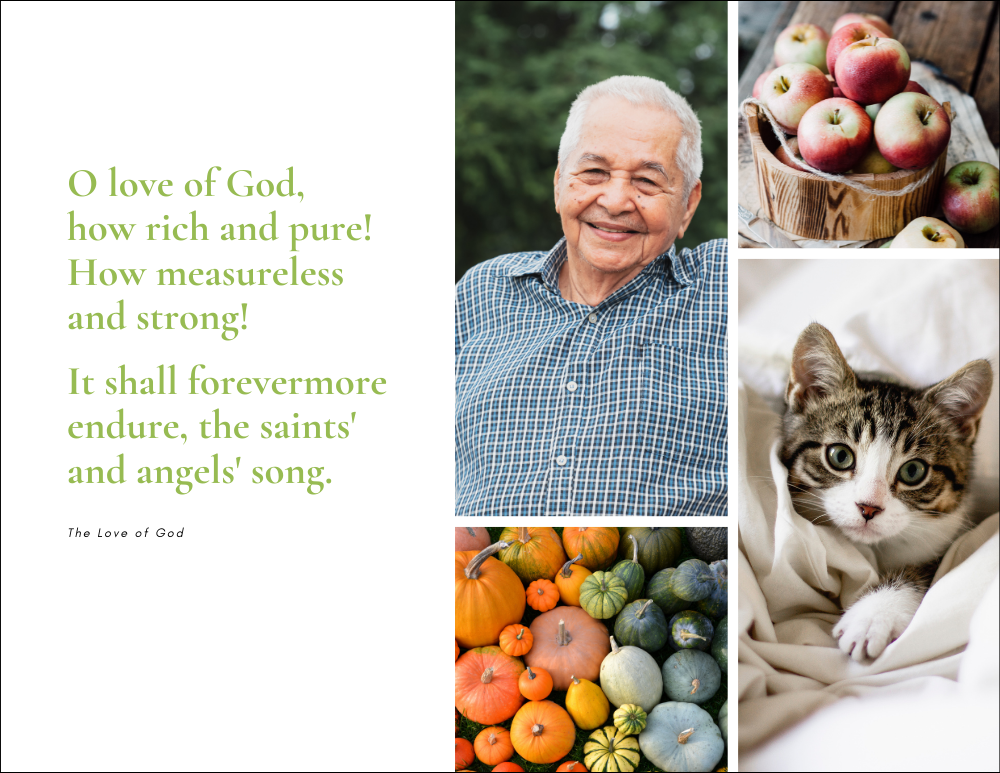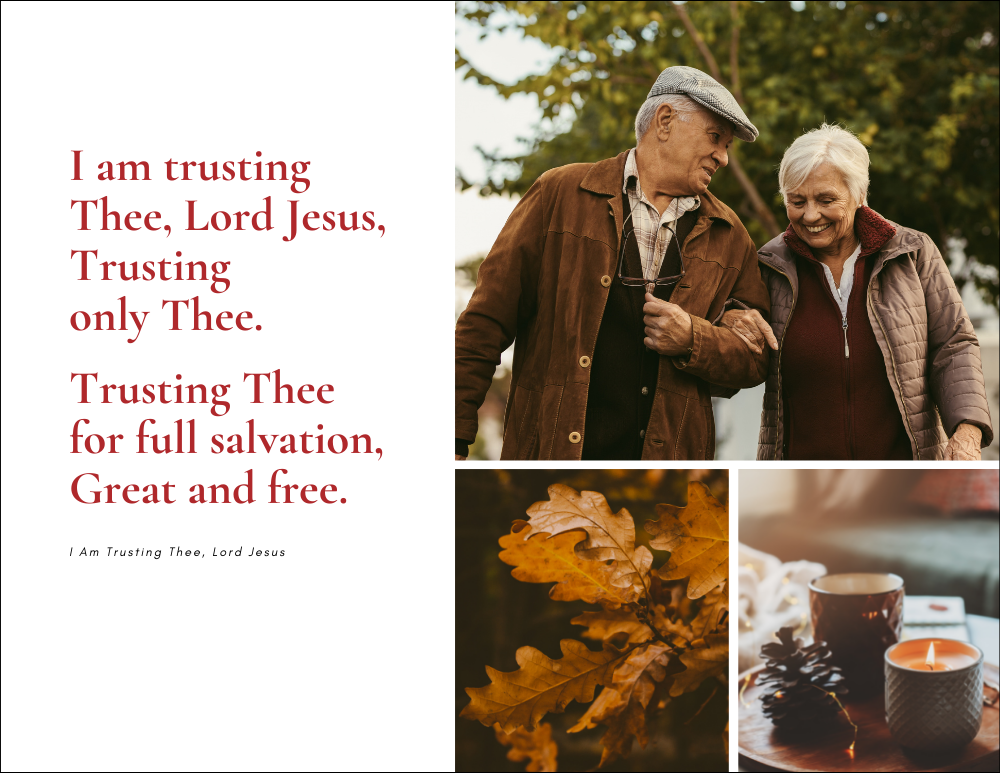Would you like the Menno Place 2023 Calendar filled with hymn stories?
Featuring some of the most beloved hymns, the Menno Place 2023 Calendar is our gift to you. Visit this page each month to read the stories behind these special hymns!
Pick up your calendar at Menno Place OR click the button below to have a calendar mailed to you.
January
All Creatures of Our God and King
Author: Francis of Assisi
Music: From the Geistliche Kirchengesang of 1623
This inspiring expression of praise found in nearly every hymnal was originally written in 1225 by one of the most interesting figures in all of church history. Giovanni Bernardone, who was better known as Saint Francis of Assisi, was a medival monk who spent his lifetime as an itinerant evangelist, preaching and helping the poor people of Italy.
Saint Francis was born in Assisi, Italy, in 1182. After an early indulgent life as a soldier, he reformed his ways dramatically, at the age of twenty-five, and determined to serve God by imitating the selfless life of Christ in all that he did. Although his family were people of considerable means, Francis scorned the possession of material goods, denounced his inherited wealth, denied himself everything but the most meager necessities, and devoted himself completely to moving about his area as Christ’s representative. At the age of twenty-eight Francis founded the influential Franciscan Order of Friars, which developed into a large movement of young men and some women who adopted his religious beliefs and ascetic style of life.
“All Creatures of Our God and King” is from one of Saint Francis’s writings entitled “Canticles of the Sun,” said to have been written one hot summer day in 1225, one year before his death, while Francis was very ill and suffering the loss of his eyesight. Throughout his life Saint Francis made much use of singing and believed strongly in the importance of church music. In all he wrote more than sixty hymns for use in the monastery. This beautiful expression of praise is one that has survived the passing of these several hundred years.
Excerpted from 101 Hymn Stories: The Inspiring True Stories Behind 101 Favorite Hymns by Kenneth W. Osbeck. pgs. 18-21.
February
Jesus Loves Me
Author: Anna B. Warner
Composer: William B. Bradbury
Without doubt the hymn that has influenced children for Christ more than any other is this simply stated one, written in 1860 by Anna Bartlett Warner. Miss Warner wrote this text in collaboration with her sister Susan as a part of one of the best-selling novels of that day, a novel written by Susan entitled Say and Seal. Today few remember the plot of that novel, which stirred the hearts of many readers. But the simple poem spoken by one of the characters, Mr. Linden, as he comforts Johnny Fax, a dying child, still remains the favorite hymn of children around the world to this day.
Anna and Susan Warner were highly educated and deeply devoted Christian young women who lived all of their lives along the Hudson River in New York. Their home was near the U.S. Military Academy at West Point, and for a number of years these two sisters conducted Sunday School classes for the young cadets. After the death of their widower father, a well-known New York lawyer, the Warner sisters were left with a meager income and of necessity turned to serious literary writing. Susan became especially noted for several of her works, including a popular book, The Wide, Wide World.
Dr. William B. Bradbury composed the music for “Jesus Loves Me” in 1861 especially for Anna Warner’s text and personally added the chorus to the four stanzas. It appeared in its present form in 1862 in his hymnal publication, “The Golden Shower.” The popularity of “Jesus Loves Me” soon spread quickly around the world. Numerous stories are told by missionaries of the universal appeal this hymn text has had with children in every culture. It is often one of the first hymns taught to new converts in foreign lands.
Excerpted from 101 Hymn Stories: The Inspiring True Stories Behind 101 Favorite Hymns by Kenneth W. Osbeck. pgs. 135-136.
March
O God, Our Help in Ages Past
Author: Isaac Watts
Composer: William Croft
Isaac Watts, often called the father of English hymnody, was born in 1674 in Southampton, England. He was the eldest of nine children. As a boy young Isaac displayed literary genius, writing verses at a very early age. It is said that he had an annoying habit of rhyming even everyday conversation. One of Watts’s early concerns was the low ebb of music in the churches. The singing consisted of ponderous hymn-psalms only. His father one day challenged him to write something better for the congregation, a challenge which he accepted. For the next two years he wrote a new hymn every Sunday. Because of this bold departure from the traditional Psalms as well as the use of his new “hymns of human composure,” Watts was generally considered to be a radical churchman in his day.
“O God, Our Help in Ages Past” is a paraphrase of Psalm 90, a psalm of Moses. It is more than a metrical version of this Psalm; it is a grand commentary on the whole subject of time, which is the theme of the Psalm.
Although Isaac Watts was frail in health during much of his life, he was a scholarly genius in many different fields. His writings include essays, discussions of psychology, three volumes of sermons, catechisms, twenty-nine treatises on theology, textbooks on logic, and a variety of other works. All of these works had a powerful influence upon the thinking of the late seventeen and early eighteenth centuries. Isaac Watts died in 1748 at the age of seventy-four. His monument was placed in Westminster Abbey, the highest honor that any Englishman can have.
Excerpted from 101 Hymn Stories: The Inspiring True Stories Behind 101 Favorite Hymns by Kenneth W. Osbeck. pgs. 183-185.
April
Christ the Lord is Risen Today
Author: Charles Wesley
Music: From Lyra Davidica, 1708
The first Wesleyan Chapel in London, England, was a deserted iron foundry. It became known as the Foundry Meeting House. This hymn was written by Charles Wesley for the first service in this chapel in 1739, just one year after Charles’s dramatic Aldersgate conversion experience. The hymn was first published in the Foundry’s Collection – which contained “hymns set to music as they are commonly sung at the Foundry.” The book had approximately fifty hymns with an additional Psalm Supplement. This hymn was originally entitled “Hymn for Easter Day” and consisted of eleven four-line stanzas.
The popularity of this hymn is due in part to the fine tune with which it has been wedded for many years. The composer of the music has never been identified. The tune first appeared anonymously in the Lyra Davidica hymnal, published in London in 1708. The joyous “alleluia” at the end of each line was not written by Wesley but was added by some editor to make the text fit the tune. “Hallelujah” or “alleluia” is from the ancient Hebrew worship service and was a common expression of praise in the early Christian Church.
Excerpted from 101 Hymn Stories: The Inspiring True Stories Behind 101 Favorite Hymns by Kenneth W. Osbeck. pgs. 47-48.
May
Joyful, Joyful, We Adore Thee
Author: Henry van Dyke
Music: Ludwig van Beethoven; Tune Name: “Hymn to Joy”
This hymn is generally considered by hymnologists to be one of the most joyous expressions of hymn lyrics in the English language. Its author, Henry van Dyke, was born in Germantown, Pennsylvania in 1852. During his lifetime he was recognized as one of the ablest Presbyterian preachers and leading liturgy figures in the country. In addition to achieving fame as a preacher, he served as a professor of literature at Princeton University from 1900-1923, was the moderator of his denomination, became a Navy chaplain during World War I, and represented his country as an ambassador to Holland and Luxembourg under an appointment by President Wilson. He was a prolific writer of devotional material with many of his books being best sellers.
This is the best-know of van Dyke’s hymns. He stated his purpose in writing it as follows:
“These verses are simple expressions of common Christian feelings and desires in this present time, hymns of today that may be sung together by people who know the thought of the age, and are not afraid that any truth of science will destroy their religion or that any revolution on earth will overthrow the kingdom of heaven. Therefore these are hymns of trust and hope.”
The text for this hymn was written while van Dyke was a guest preacher at Williams College, Williamstown, Massachusetts. It is said that one morning van Dyke handed the manuscript to the college president, saying, “Here is a hymn for you. Your mountains (the Berkshires) were my inspiration. It must be sung to the music of Beethoven’s “Hymn of Joy.” The tune, “Hymn of Joy,” comes out of the final movement of Beethoven’s Ninth Symphony, composed from 1817-23, and published in 1826. Although Beethoven never wrote a tune specifically for a hymn text, a number have been adapted from his many famous works. This is the most widely used of these adopted hymn tunes.
Excerpted from 101 Hymn Stories: The Inspiring True Stories Behind 101 Favorite Hymns by Kenneth W. Osbeck. pgs. 143-145.
June
In The Garden
Author & Composer: C. Austin Miles
It was in 1912 that music publisher Dr. Adam Geibel asked C. Austin Miles to write a hymn text that would be “sympathetic in tone, breathing tenderness in every line; one that would bring hope to the hopeless, rest for the weary, and downy pillows to dying beds.” Miles has left the following account of the writing of this hymn:
“One day in March, 1912, I was seated in the dark room, where I kept my photographic equipment and organ. I drew my Bible toward me; it opened at my favorite chapter, John 20 – whether by chance or inspiration let each reader decide. That meeting of Jesus and Mary had lost none of its power to charm.
As I read it that day, I seemed to be part of the scene. I became a silent witness to that dramatic moment in Mary’s life, when she knelt before her Lord, and cried, ‘Rabboni!’ … I awakened in full light, gripping the Bible, with muscles tense and nerves vibrating. Under the inspiration of this vision I wrote as quickly as the words could be formed the poem exactly as it has since appeared. That same evening I wrote the music.”
Next to “The Old Rugged Cross” this hymn has been one of the most popular gospel hymns ever written.
Excerpted from 101 Hymn Stories: The Inspiring True Stories Behind 101 Favorite Hymns by Kenneth W. Osbeck. pgs. 123-125.
July
O Worship the King
Author: Robert Grant
Composer: Arranged from J. Michael Haydn; Tune Name: “Lyons”
This hymn, written and published in 1833 in a hymnal entitled Christian Psalmody, is one of the finest from the early nineteenth century Romantic Era. It has often been called a model hymn for worship. It has few equals in expressive lyrics in the exaltation of the Almighty. Each of the epithets applied to God-King, Shield, Defender, Ancient of Days, Maker, Redeemer, Friend – as well as the vivid imagery – such as, “His chariots of wrath the deep thunderclouds form” and the references to His attributes – power, might, grace, bountiful care, love – all combine to describe with literary eloquence and spiritual warmth the majesty and praise-worthiness of our God.
Sir Robert Grant was born into a setting of high political life in Bengal, India, in 1779. His father, Charles, was a respected ranking leader in India and a director of the East India Company. He was also a zealous leader in the evangelical wing of the Anglican Church. Robert, too, became active in business and politics and eventually was appointed Governor of Bombay in 1834. Like his father, Robert was a devout and deeply spiritual lay evangelical Christian all of his life. Robert maintained a strong interest in the missionary outreach of the church throughout his lifetime. In 1839, a year after his death in India, his brother had twelve of Robert’s poems published in a little volume entitled Sacred Poems.
Excerpted from 101 Hymn Stories: The Inspiring True Stories Behind 101 Favorite Hymns by Kenneth W. Osbeck. pgs. 200-202.
August
All the Way My Savior Leads Me
Author: Fanny J. Crosby
Composer: Robert Lowry
This beloved gospel hymn was the expression of gratitude to God after a direct answer to prayer. It is reported that one day Fanny Crosby desperately needed five dollars and did not know where she could obtain this amount. As was her custom, she began to pray about this matter. Within a few minutes a stranger appeared at her door with just the right amount. “I have no way of accounting for this,” she wrote, “except to believe that God, in answer to my prayer, put it into the heart of this good man to bring the money. My first thought was, it is so wonderful the way the Lord leads me. I immediately wrote the poem and Dr. Lowry set it to music.”
Fanny Jane Crosby was born of humble parents in New York in 1823. She was blinded at the age of six weeks by improper medical treatment. Throughout her lifetime she was a faithful member of the St. John’s Methodist Episcopal Church in New York City. She was educated at the New York School for the Blind. From 1847 to 1858 she served as a teacher at this school. In 1858 she married a blind musician, Alexander Van Alstyne, a highly respected teacher of music at the blind institution. Through the influence of a well-known church musician, W.B. Bradbury, Fanny began, in her early forties, to write gospel song lyrics in earnest and became the “happiest creature in all the land”.
Excerpted from 101 Hymn Stories: The Inspiring True Stories Behind 101 Favorite Hymns by Kenneth W. Osbeck. pgs.25-27.
September
The Love of God
Author & Composer: Frederick M. Lehman
This beloved gospel song has its roots in a Jewish poem, written in Germany in the eleventh century. The Jewish poem, Hadamut, in the Aramaic language, has ninety couplets. The poem itself is in the form of an acrostic, with the author’s name woven into the concluding verses. It was composed, in the year 1096, by Rabbi Mayer, son of Isaac Nehorai, who was a cantor in the city of Worms, Germany.
Frederick Martin Lehman pastored Nazarene churches, throughout his ministry in Indiana and Illinois, before moving to Kansas City in 1911, where he became involved in starting the Nazarene Publishing House. Throughout his ministry, Frederick Lehman wrote numerous poems and songs, including the publishing of five volumes of Songs That Are Different. “The Love of God” first appeared in Volume Two of that series, in 1919.
Excerpted from 101 More Hymn Stories: The Inspiring True Stories Behind 101 Favorite Hymns by Kenneth W. Osbeck. pgs. 271-273.
October
Count Your Blessings
Author: Johnson Oatman Jr.
Composer: Edwin O. Excell
This hymn certainly ranks as one of the most familiar numbers in our hymnals. It is one of the songs that many of us first sang with gusto during our early Sunday School days, yet one that we still enjoy signing in our gospel services.
Rev. Johnson Oatman Jr., was one of the most important and prolific gospel song writers of the late nineteenth and early twentieth centuries. He was born in New Jersey in 1856. As a child he became acquainted with the hymns of the church through the singing talents of his father.
At the age of nineteen Oatman joined the Methodist Church and several years later was granted a license to preach in local Methodist congregations. Though he wrote over 5,000 hymn texts, Oatman was busily engaged throughout his life in a mercantile business and later as an administrator for a large insurance company. “Count Your Blessings” is generally considered to be Oatman’s finest hymn. It has been sung all over the world and perhaps no American hymn was ever received with such enthusiasm in Great Britain as this hymn.
The composer of the music, E.O. Excell, is a well-known name in early gospel hymnody. At the age of twenty, he became a singing teacher, traveling around the country establishing singing schools. In addition to writing and composing more than 2,000 gospel songs as well as publishing about fifty songbooks, he administered a successful music publishing business in Chicago.
Excerpted from 101 Hymn Stories: The Inspiring True Stories Behind 101 Favorite Hymns by Kenneth W. Osbeck. pgs. 54-56.
November
I Am Trusting Thee, Lord Jesus
Author: Frances Ridley Havergal
Composer: Ethelbert W. Bullinger
This is another of the child-like, but beautiful expressions from the soul of the esteemed English poetess, Frances Ridley Havergal, often referred to as “the Sweetest Voice of Hymnody.” Though highly educated and cultured, Miss Havergal always maintained a simple, child-like faith and confidence in her Lord. She is generally called “the consecration poet,” since her hymns so reflect this quality. Her entire life was characterized by spiritual saintliness. It is said that she never wrote a line of verse without first fervently praying over it, and then she gave God all the credit for its composition:
“I believe my King suggests a thought, and whispers me a musical line or two, and then I look up and thank Him delightedly and go on with it. That is how my hymns come.”
Frances was born in Worcestershire, England in 1836. At the age of three, she could read, and at the age of seven, she was already writing verses. She became a natural linguist, mastering French, German, Italian, Latin, Greek, and Hebrew. She was also a devoted Bible student, memorizing much of the New Testament as well as the Psalms, Isaiah, and the Minor Prophets. Her numerous little books of poems and hymn texts are now treasured all over England and America. Frances Havergal died at the early age of forty-two in 1879.
Excerpted from 101 More Hymn Stories: The Inspiring True Stories Behind 101 Favorite Hymns by Kenneth W. Osbeck. pgs. 127-129.
December
Joy to the World!
Author: Isaac Watts
Composer: Possibly adapted from G.F. Handel
Arranged by: Lowell Mason
Joy is the keynote of the entire Advent season, especially for the Christian, who realizes its spiritual significance – God Himself invading this world and providing a means whereby sinful man might live eternally. This text is generally considered to be one of the most joyous Christmas hymns in existence, not in the sense of merry-making, but in the deep and solemn realization of what Christ’s birth has meant to mankind.
This advent hymn is another of Watts’ hymns from his well-known hymnal of 1719, Psalms of David Imitated in the Language of the New Testament. It was Isaac Watts’ intent in writing this collection to give the Psalms a New Testament meaning and style. “Joy to the Word!” is a paraphrase of these verses taken from the last half of Psalm 98:
“Make a joyful noise unto the Lord, all the earth; make a loud noise, and rejoice, and sing praise. Let the floods clap their hands; let the hills be joyful together before the Lord; for He cometh to judge the earth; with righteousness shall He judge the world, and the people with equity.”
Watts has given this verse a fresh interpretation – a New Testament expression of praise for the salvation that began when God became incarnate as the Babe of Bethlehem and was destined to remove the curse of Adam’s fall. Isaac Watts first titled his text “The Messiah’s Coming and Kingdom.”
You can read more about Isaac Watts’ life in March’s hymn story above.
Excerpted from 101 More Hymn Stories: The Inspiring True Stories Behind 101 Favorite Hymns by Kenneth W. Osbeck. pgs. 166-169.
January 2024
Trusting Jesus
Author: Edgar Page Stites
Composer: Ira D. Sankey
As believers, it is important that we allow a simple gospel hymn with such a profound truth as this to minister to us daily:
Simply trusting every day, trusting through a stormy way;
Even when my faith is small, trusting Jesus – that is all.
Singing if my way is clear, praying if the path be drear;
If in danger, for Him call, trusting Jesus – that is all.
Ira D. Sankey, the composer, relates the following incident regarding the birth of this hymn:
“The words of this hymn were handed to Mr. Moody in Chicago in 1876 in the form of a newspaper clipping. He gave them to me, and asked me to write a tune for them. I assented, on condition that he should vouch for the doctrine taught in the verses, and he said he would.”
The hymn was first published in Sankey’s Gospel Hymns No. 2 in 1876. It was widely used in the great Moody and Sankey evangelistic meetings in the ensuing year. This textually and musically simple expression of child-like trust in Jesus has met the daily spiritual needs of many of God’s people to the present time.
The author, Edgar Page Stites, was for many years an obscure but active lay-worker in the Methodist Church of Cape May, New Jersey. Mr. Stites served in the Civil War and later for a time was a riverboat pilot. He also worked for a period as a Methodist home missionary in the Dakotas.
Excerpted from 101 More Hymn Stories: The Inspiring True Stories Behind 101 Favorite Hymns by Kenneth W. Osbeck. pgs. 293-296.








